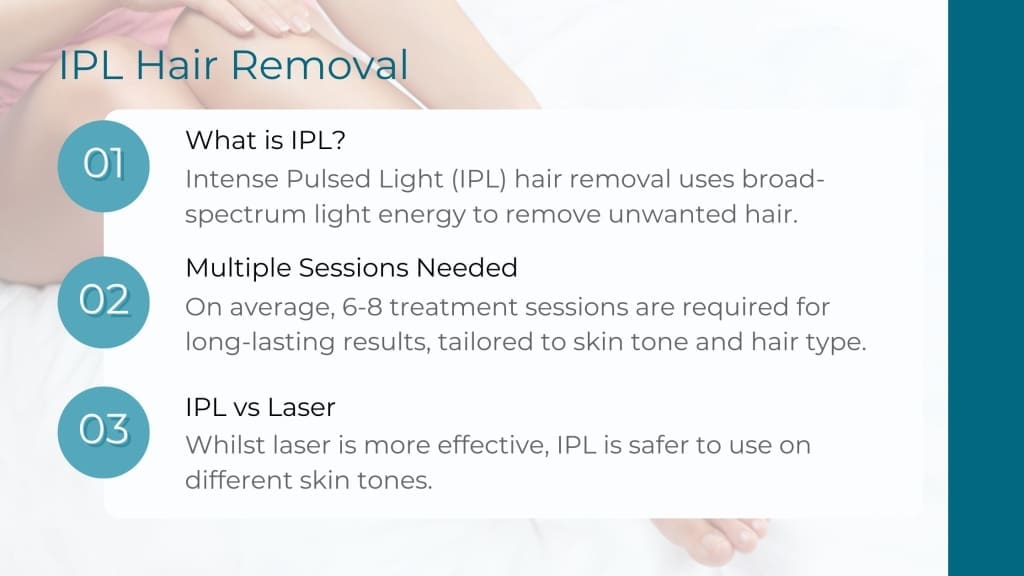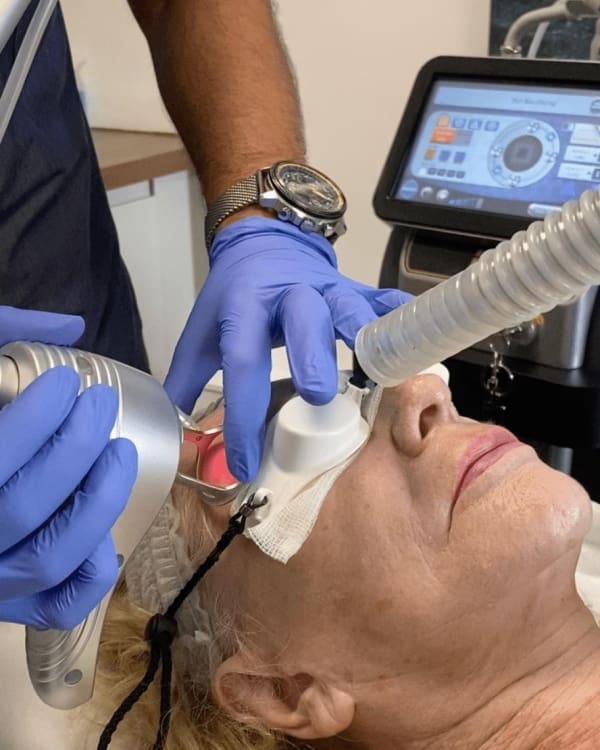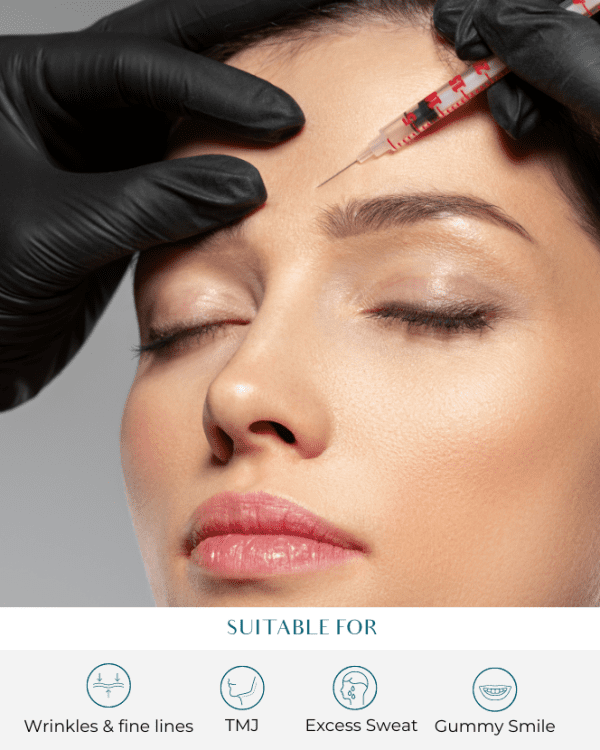What is Intense Pulse Laser Hair Removal?
What is Intense Pulse Laser Hair Removal?
Intense Pulsed Light (IPL) hair removal is an advanced, non-invasive cosmetic procedure that uses broad-spectrum light energy to target and eliminate unwanted hair. Unlike laser hair removal, which uses a single wavelength of light, IPL technology emits multiple wavelengths of light, ranging from 400nm to 1200nm. Laser treatment, on the other hand, is generally more efficient, providing faster and longer-lasting results with fewer sessions. This versatile light therapy can effectively treat various skin and hair types, making it a popular choice for those seeking long-lasting hair reduction.

What is IPL?
Intense Pulsed Light (IPL) is a non-invasive, non-surgical cosmetic treatment that harnesses high-intensity pulses of light to address a variety of skin concerns. This versatile technology is widely used for hair removal, but its benefits extend far beyond that. IPL works by emitting multiple wavelengths of light energy, which penetrate the skin and are absorbed by targeted cells. This process heats and breaks down the cells, allowing the body to naturally eliminate them. Whether you’re looking to remove unwanted hair, reduce signs of aging, or improve the appearance of scars and spider veins, IPL offers a comprehensive solution for enhancing your skin’s appearance.
How Does IPL Hair Removal Work?
IPL hair removal works by delivering intense pulses of light that are absorbed by the melanin in the hair follicles. The light energy is converted to heat, which damages the hair follicles and inhibits future hair growth. The IPL device emits short pulses of light that selectively target the pigment in the hair while leaving the surrounding skin unaffected. However, IPL treatments can pose risks such as burns or changes in skin color, particularly for those with darker skin. This process is most effective during the active growth phase of the hair cycle, which is why multiple treatment sessions are typically required for optimal results.
What is the difference between IPL and Laser Hair Removal?
The main difference between IPL and laser hair removal is the type of light used. IPL is better suited for darker skin tones.
IPL uses a broad spectrum of light, while laser uses a single wavelength of light. This means that IPL is less targeted than laser, and can affect more of the surrounding skin. As a result, IPL is generally less effective than laser, and may require more treatments to achieve the same results.
When it comes to hair removal, both IPL and laser treatments are popular choices. Laser hair removal uses a single, concentrated wavelength of light to precisely target hair follicles, making it particularly effective for individuals with darker hair and lighter skin. This precision often results in fewer treatment sessions to achieve desired results.
On the other hand, IPL employs multiple wavelengths of light, making it a more versatile option suitable for a broader range of skin and hair types. However, this versatility may mean that more sessions are needed to achieve optimal hair reduction. Ultimately, the choice between IPL and laser hair removal depends on your specific skin and hair characteristics, as well as your personal preferences.
What Are the Benefits of IPL Hair Removal?
IPL hair removal offers numerous advantages over traditional hair removal methods:
- Non-invasive and comfortable: The procedure is relatively painless, with most people experiencing only a slight stinging sensation during treatment.
- Versatile: IPL can be used on various body areas, including the face, underarms, legs, arms, bikini line, and more.
- Long-lasting results: With regular treatments, IPL can achieve permanent hair reduction, eliminating the need for daily shaving or frequent waxing.
- Improved skin texture: IPL treatments can lead to smoother skin by reducing irritation and ingrown hairs often associated with shaving.
Additionally, IPL is effective for individuals with light brown skin, helping to reduce various skin issues such as aging signs and hyperpigmentation more efficiently compared to darker skin types.
- Quick and convenient: Sessions are typically short, and there is minimal downtime following treatment.
Who is a Good Candidate for IPL Hair Removal?
IPL hair removal is most effective for individuals with:
- Dark hair and light to medium skin tones
- Coarse, thick hair
- Unwanted hair on various body areas
However, IPL may not be suitable for everyone. People with very dark skin, light blonde or white hair, or certain skin conditions should consult a professional before undergoing treatment[2][4].
Are There Any Side Effects or Risks Associated with IPL Hair Removal?
While IPL hair removal is generally safe when performed by a trained professional, there are some potential side effects to be aware of:
- Temporary redness or swelling of the treated area
- Mild discomfort or a sensation similar to a sunburn
- Slight skin discoloration, which usually resolves on its own
- In rare cases, blistering or scarring may occur, particularly for those with sensitive skin
It’s important to note that these side effects are typically mild and short-lived
How Many IPL Sessions Are Needed for Optimal Results?
The number of IPL sessions required varies depending on individual factors such as hair color, skin tone, and the treatment area. Most people need between 6 to 8 treatments, spaced 4 to 6 weeks apart, to achieve significant hair reduction. Maintenance sessions may be necessary to sustain the results long-term.
How Should I Prepare for an IPL Hair Removal Treatment?
To ensure the best possible results and minimize potential side effects, follow these pre-treatment guidelines:
- Avoid sun exposure and tanning beds for at least two weeks before treatment
- Discontinue use of retinoid creams and other photosensitizing medications
- Shave the treatment area 24-48 hours before your appointment
- Avoid waxing, plucking, or electrolysis for several weeks prior to treatment
What Should I Expect During and After an IPL Treatment?
During the treatment, you may experience a slight stinging sensation, often described as feeling like a rubber band snapping against the skin. Afterward, the treated area may appear red and feel sensitive for a few hours. Apply ice packs or cool compresses to soothe any discomfort. It’s crucial to protect the treated skin from sun exposure and use a broad-spectrum sunscreen with an SPF of at least 30.
At-Home IPL Devices
At-home IPL devices have revolutionized the way we approach hair removal, offering the convenience of professional treatments right in the comfort of our own homes. These devices utilize intense pulsed light technology to target hair follicles, gradually reducing hair growth over time. While at-home IPL devices are designed for ease of use, it’s important to note that they may not be as powerful or effective as professional treatments. Results can vary based on individual skin and hair types, and it’s crucial to follow the manufacturer’s instructions carefully to avoid side effects like redness, swelling, and skin irritation. With consistent use and proper precautions, at-home IPL devices can be a valuable tool in your hair removal routine.
Intense Pulsed Light Therapy for Skin Concerns
Intense Pulsed Light therapy isn’t just for hair removal; it’s also a powerful tool for addressing a variety of skin concerns. This advanced technology can help reduce hyperpigmentation, rosacea, and acne, making it a versatile option for improving overall skin health. By targeting specific areas with intense pulsed light, IPL can diminish the appearance of fine lines and wrinkles, enhance skin texture, and even out skin tone. Additionally, IPL is effective in treating vascular lesions like spider veins and port-wine stains. By addressing these skin issues, IPL therapy can leave your skin looking smoother, brighter, and more radiant, providing a comprehensive solution for a range of cosmetic concerns.
Is IPL Hair Removal Right for Me?
While IPL hair removal is an effective solution for many people, it’s essential to consult with a qualified professional to determine if it’s the right choice for you. Factors such as your skin tone, hair color, and any underlying skin conditions will be considered when assessing your suitability for IPL treatment. A thorough consultation will help ensure that you achieve the best possible results while minimizing any potential risks.































































